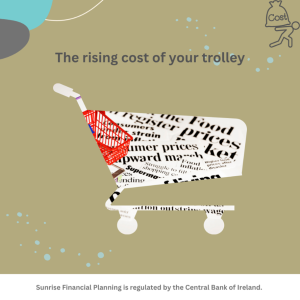We have all noticed the rising cost of goods in our shopping trolley in recent times!
Recent data shows that grocery prices in supermarkets are now more than 5% higher than a year ago, far outpacing the general inflation rate of 1.6% for June 2025 in the last 12 months (ref CSO).
The rising cost of food is being cited as the main driver of inflation in Ireland, despite a small drop in the cost of energy. That said, inflation remains below what we experienced following the Covid-19 pandemic, and the Russian invasion of Ukraine.
The European Central Bank closely monitors inflation to ensure it remains around the 2% target, taking action if it deviates drastically from this. It has indicated that it sees inflation effectively contained in Ireland, but higher food prices are impacting consumer sentiment. It estimates that inflation will settle at 2pc in the medium term, following a dip below that level in 2026.
Did you know ?
That a weekly basket that cost €87.06 in April 2022 now costs €115.93 (as of March 2025) – that’s an increase of €28.87, or 33%! When annualised that’s €1,500 more per year just for basic groceries.
The table below shows a few standout price hikes on the stables since 2022.
| Item | 2022 Price | 2025 Price | Increase |
| Chicken Breasts 1 kg | €4.99 | €10.99 | + €6.00 |
| Heinz Beans 4 Pack | €3.50 | €5.50 | + €2.00 |
| Denny Sausages | €2.69 | €3.89 | + €1.20 |
| Own Brand Milk 2 Ltr | €1.69 | €2,45 | + €0.76 |
What is driving these increases?
- Raw Material Costs: Global shortages, climate change (e.g. droughts in Canada, storms in Spain), and war in Ukraine have driven up costs for core ingredients.
- Energy and Transport: Prices for fuel and transport remain elevated.
- Climate Effects: Cocoa, coffee, and wheat are among the hardest hit, leading to steep price rises in chocolate, coffee, pasta.
- Supply Chain Disruptions: Lingering post-COVID disruptions, compounded by geopolitical tensions, have kept supply chains expensive and unstable.
- Labour Costs: Wage increases in production, packaging, and retail sectors have added to prices — not necessarily benefiting consumers.
How have consumer habits changed?
Spending habits are changing significantly. Many Irish consumers have become increasingly price-sensitive, prioritising value by shifting towards ‘own-label’ products and discount shops to stretch their budget amid the rising cost of living. Around 56% of consumers actively seek ways to reduce daily expenses, focusing on essentials and cutting back on non-essentials like clothing and luxury items.
The growing popularity of pre-loved markets for clothing (Vinted and Depop) and designer clothes rental shops plays an important role in keeping costs down, as well as reflecting the shift toward sustainability.
It certainly pays to shop around as prices can vary significantly from shop to shop. The same principle applies to your utilities, house, car, or health insurance. Taking the time to compare prices and options can help you save a substantial amount of money and give you more bang for your buck!


